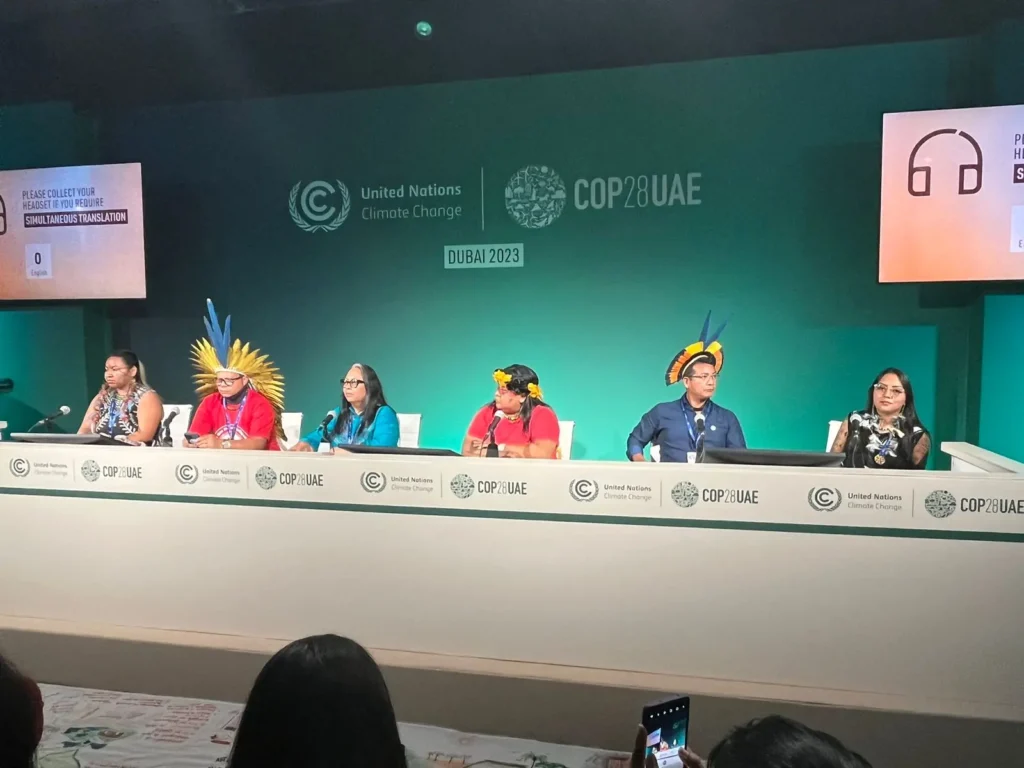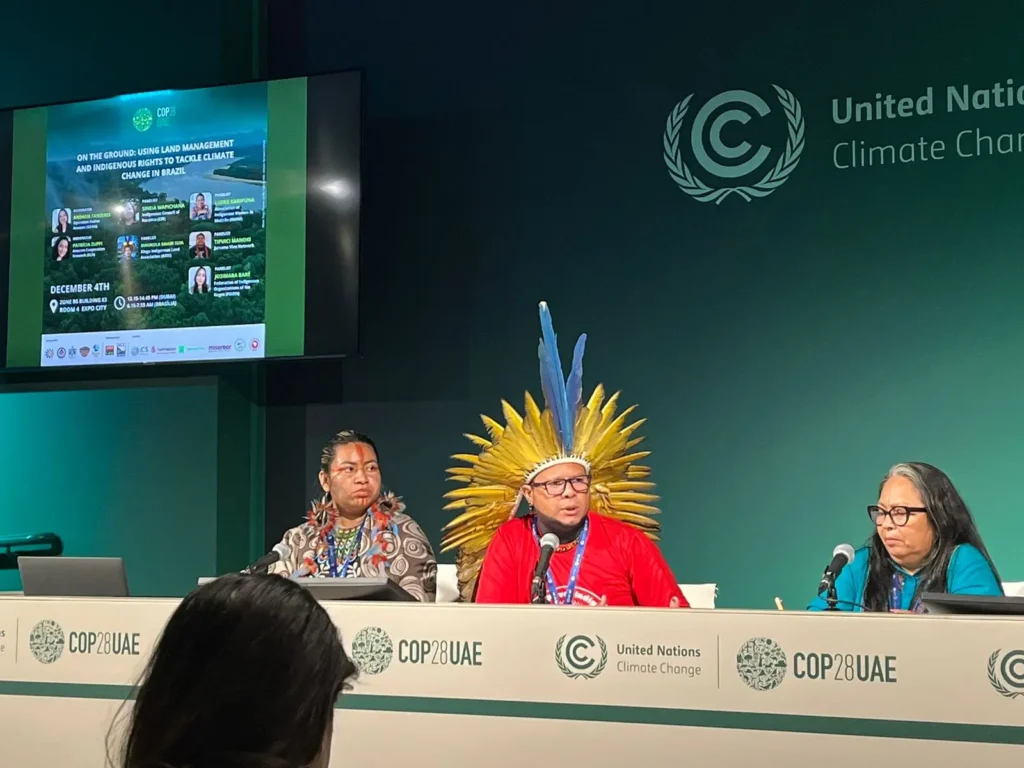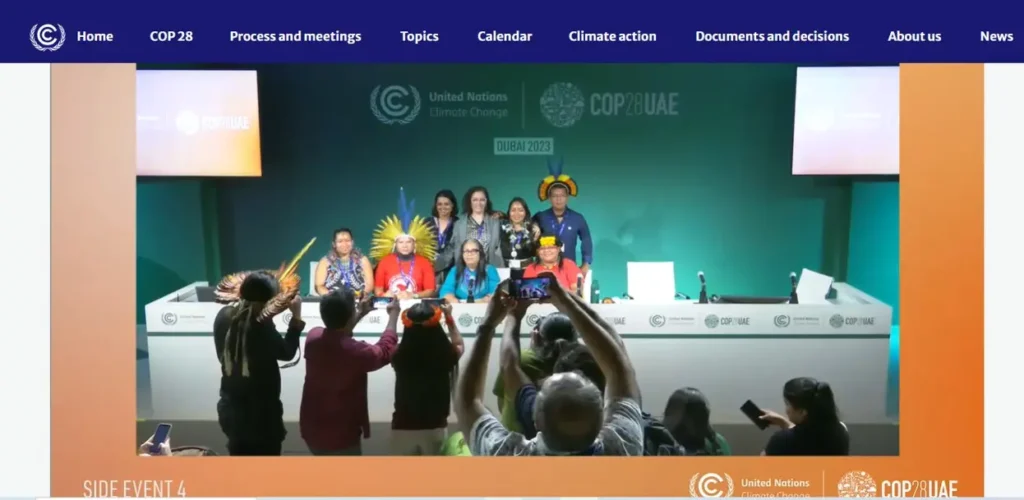Dubai, United Arab Emirates – Keeping up with its commitment to the COP28 a vision of the future, built by the indigenous people of the State, family members, and partners, Sineia groups intersect, and the staff of the Council for the Indian state of Roraima (CIR), opened on Monday, 4 December, a long cloth with drawings and messages of the territories that were made during the exchange of experience on climate change, held in the Indigenous territory of Raposa Serra do Sol, in October, 2023. It was during the side-event titled “In the land: by using the stewardship of the earth and of the rights of indigenous peoples to climate change in Brazil”, which was moderated by a operação Amazônia Nativa (OPAN), and by the co-operation of the Amazon (the car), with the support of a variety of indigenous organizations of the Amazon, and on the Network of the Juruena-Alive.
In the event you have been raised in the cases concerned about personal development plans, land use management, to cope with climate change, report of the consultation, and the funds are indigenous people have been taken to ensure the well-being of communities, and as a result, the balance of the climate in Brazil. “To implement the development plans and implement your dreams. How much does it cost to do this? What is measurable and what is not is it?” he wondered Sineia, the national coordinator of the Indian Committee on Climate Change (CIMC).

Examples of the challenges to which the instruments are made out of paper that have been emphasized in the words of the Luene the Karipuna, the Women’s Association of Indigenous peoples of the task force (AMIM), in the northern brazilian state of Amapá, in the context of the pressures for the exploration of oil in the mouth of the Amazon river. According to her, there are already a lot of speculation and it might be the appearance of any concrete impact on the health and indigenous societies. The pioneers in the development of the first protocols of the consultation and the development plans of the peoples of the northern brazilian state of Amapá strive to make the best use of the veto right in the projects of the great, and dangerous to the environment and the culture of the communities at a time when climate change has already come, and aggravate their vulnerability. “My people are not eating flour from the cassava for two years without making a few, some in the traditional sense. We have power over our lives,” he cried.
In the same vein, Martha Tipuici of the Manoki people, has dealt with the pressure of more than 180 enterprises hydroelectric power plants in the basin of the rio Juruena, Mato Grosso, on the territories of indigenous peoples, with small power plants to act without transparency, without the study are robust and in violation of the protocol to query, and the plan for the adoption of the programme of the people. “We don’t see a reason to further the construction of hydroelectric power plants for power generation, you will benefit from the same person, and that is harmful to our well-being,” said Martha, Tipuici. In the words of the Ianukula the Kaiabi the Suiá, the president of the Xingu Indigenous Land Association (ATIX), it has been pointed out in a comprehensive process of consultation with the indigenous peoples of the Xingu river on the Railway Integration in the midwest (I) and BR-242. As it was completed I Karipuna, the only protocols can be implemented on the basis of a lot of pressure on the government.

Another awe-inspiring experience is the Background for the Indian (the END), which was presented by its director, Josimara Baré, which is created by the Federation of Indigenous Organizations of the Rio Negro (FOIRN) for the implementation of the management plans of the peoples of the region. It is the first official announcement of 2021, which has resulted in the support of nearly one million dollars in 15 projects, five of which are in the culture, the three-food-safety-and-seven from the sustainable economics of the indigenous, for the benefit of more than eight thousand of the indigenous people. “To support the projects of the well-to live is to fight against climate change, because it is we who are the guardians of the forest,” he said Josimara. To Sineia groups intersect in the discussion on climate finance, and direct access to the resources of the indigenous peoples), one of the most important in the present time, this is the experience of hope.
“I have the funds to indigenous peoples is the perfect solution for a quick response, the indigenous people need to deal with the effects of climate change in the region
Sineia Groups Intersect
According to Patti, Zuppi, in the CAR, which has been providing support ever since the fall of 2017 and representatives of indigenous organizations of the basis of the network is in the process of the impact of the international climate, these experiences are associated with the National Policy for the Management of the Environmental, Territorial and Indigenous Lands (PNGATI) need to be appreciated for your results to be able to influence the terms of trade. “Our main effort has been in support of the indigenous peoples of these places to take your place in the leading role, both on the outside and inside of the bodies of the decision, the official Convention of the Weather for the middle of the advocacy work and capacity building, particularly,” says Patricia. In addition to this, it is a work in progress, and that the COP30 be able to get coverage that is even more extensive. “The trial of the impact on the climate, is the strengthening of the national authorities, particularly now that it’s being revived, the Technical council on Climate Change of the Committee on the PNGATI the CIMC,” he said.

“A major strategy in the fight against climate change is to ensure that the delimitation and demarcation of indigenous lands, as well as the schedule for the creation of protected areas and the protection of the area. Effective public policies for indigenous peoples is the key solution to addressing the climate crisis as a whole, this discussion is completely connected to the PNGATI,” says I Karipuna of the APIB.
The discussion In the territory, using the management of the land and of the rights of indigenous peoples to climate change in Brazil:” it was a realization of the Indigenous Council of Roraima (CIR), in the Xingu Indigenous Land Association (ATIX), the Association of Indigenous Women of the task force (AMIM), the Network of the Juruena Living and the federal association of the Indigenous Peoples of the Rio Negro (FOIRN), with the organization of the Operation of the Amazon-Native (OPAN), and the Network of Cooperation to the Amazon (the car), in support of the Articulation of the Indigenous Peoples of Brazil (APIB), and the Coordination of the Indigenous Organizations of the Brazilian Amazon (COIAB).
